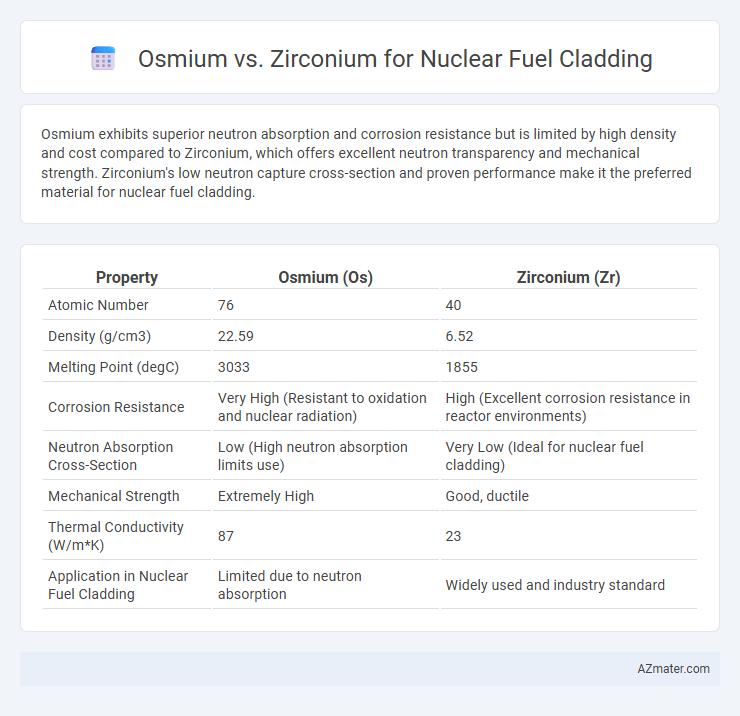Osmium exhibits superior neutron absorption and corrosion resistance but is limited by high density and cost compared to Zirconium, which offers excellent neutron transparency and mechanical strength. Zirconium's low neutron capture cross-section and proven performance make it the preferred material for nuclear fuel cladding.
Table of Comparison
| Property | Osmium (Os) | Zirconium (Zr) |
|---|---|---|
| Atomic Number | 76 | 40 |
| Density (g/cm3) | 22.59 | 6.52 |
| Melting Point (degC) | 3033 | 1855 |
| Corrosion Resistance | Very High (Resistant to oxidation and nuclear radiation) | High (Excellent corrosion resistance in reactor environments) |
| Neutron Absorption Cross-Section | Low (High neutron absorption limits use) | Very Low (Ideal for nuclear fuel cladding) |
| Mechanical Strength | Extremely High | Good, ductile |
| Thermal Conductivity (W/m*K) | 87 | 23 |
| Application in Nuclear Fuel Cladding | Limited due to neutron absorption | Widely used and industry standard |
Introduction to Nuclear Fuel Cladding Materials
Nuclear fuel cladding materials must withstand extreme temperatures, radiation, and corrosion while maintaining structural integrity. Osmium offers exceptional hardness and high melting point but is rare and expensive, limiting its practical application. Zirconium alloys are widely preferred in nuclear reactors due to their excellent corrosion resistance, low neutron absorption cross-section, and mechanical stability under irradiation.
Osmium and Zirconium: Elemental Properties Overview
Osmium is a dense, hard transition metal with a high melting point of 3033degC and exceptional corrosion resistance, making it theoretically advantageous for nuclear fuel cladding in extreme environments. Zirconium, characterized by its low neutron absorption cross-section and strong resistance to corrosion in high-temperature water, remains the industry standard for cladding materials in nuclear reactors. The elemental properties of osmium, such as its brittleness and rarity, contrast with zirconium's ductility and abundance, influencing their practical selection for nuclear fuel cladding applications.
Historical Use of Zirconium in Nuclear Reactors
Zirconium has been the preferred material for nuclear fuel cladding since the 1950s due to its low neutron absorption cross-section and excellent corrosion resistance in high-temperature reactor environments. Its historical and widespread use in light water reactors (LWRs) ensures reliable containment of nuclear fuel while maintaining reactor efficiency. Osmium, while possessing high density and corrosion resistance, lacks extensive research and practical application data for fuel cladding, limiting its viability compared to zirconium.
Emerging Interest in Osmium for Nuclear Applications
Osmium's exceptional corrosion resistance and high melting point have sparked emerging interest for nuclear fuel cladding, offering enhanced durability in extreme reactor environments compared to zirconium. Unlike zirconium, which suffers from oxidation and hydrogen embrittlement under high-temperature steam conditions, osmium's dense atomic structure provides superior chemical stability and radiation resistance. Recent studies highlight osmium alloys as promising candidates for next-generation reactors, aiming to improve safety and longevity in nuclear fuel performance.
Corrosion Resistance: Osmium vs Zirconium
Osmium exhibits superior corrosion resistance compared to zirconium, showing extraordinary stability in highly aggressive nuclear reactor environments, including exposure to high-temperature steam and radiation. Zirconium alloys, commonly used in nuclear fuel cladding, form a protective oxide layer but remain vulnerable to oxidation and hydriding under extreme conditions. The enhanced corrosion resistance of osmium could potentially increase fuel cladding lifespan and safety margins by minimizing material degradation in reactor cores.
Neutron Absorption Cross-Section Comparison
Osmium exhibits a significantly higher neutron absorption cross-section compared to zirconium, making it less favorable for nuclear fuel cladding applications where minimal neutron capture is critical. Zirconium's low neutron absorption cross-section enhances reactor efficiency by allowing more neutrons to sustain the chain reaction. This characteristic makes zirconium alloys, such as Zircaloy, the preferred choice for cladding materials in light water reactors due to their optimal balance of mechanical properties and neutron transparency.
Mechanical Strength and Thermal Stability
Osmium exhibits superior mechanical strength with a high melting point of 3033degC and excellent resistance to deformation under extreme conditions, making it highly durable for nuclear fuel cladding. Zirconium, renowned for its low neutron absorption cross-section and good mechanical properties, demonstrates remarkable thermal stability up to about 1850degC, ensuring efficient heat transfer and corrosion resistance in reactor environments. Comparing both, osmium's exceptional hardness and thermal resilience offer advantages in scenarios requiring enhanced structural integrity, while zirconium's performance in neutron economy and oxidation resistance remains critical for sustained reactor safety.
Economic Factors and Material Availability
Osmium is rarely used for nuclear fuel cladding due to its extreme scarcity and high cost, making it economically unfeasible compared to zirconium, which is abundant and more affordable. Zirconium alloys, particularly Zircaloy, dominate the cladding market due to their optimal balance of corrosion resistance, mechanical strength, and cost-effectiveness. The widespread availability of zirconium sourced from minerals like zircon ensures reliable supply chains, reducing economic risks associated with nuclear fuel cladding production.
Safety and Environmental Considerations
Osmium's extreme density and corrosion resistance offer superior protection against radiation leakage and chemical degradation in nuclear fuel cladding, enhancing reactor safety. Zirconium's low neutron absorption cross-section minimizes interference with the nuclear reaction, improving fuel efficiency while maintaining structural integrity under high temperatures. Environmental impact favors zirconium due to its greater abundance and less toxic byproducts during manufacturing and disposal processes, reducing ecological risks associated with nuclear waste management.
Future Prospects and Research Directions
Osmium and zirconium exhibit distinct properties influencing their potential in nuclear fuel cladding, with zirconium currently dominating due to its low neutron absorption and corrosion resistance. Future prospects for osmium focus on its exceptional density and radiation tolerance, which could enhance fuel rod integrity under extreme reactor conditions. Ongoing research aims to optimize alloys and surface treatments of both metals to improve their performance and safety in next-generation nuclear reactors.

Infographic: Osmium vs Zirconium for Nuclear Fuel Cladding
 azmater.com
azmater.com